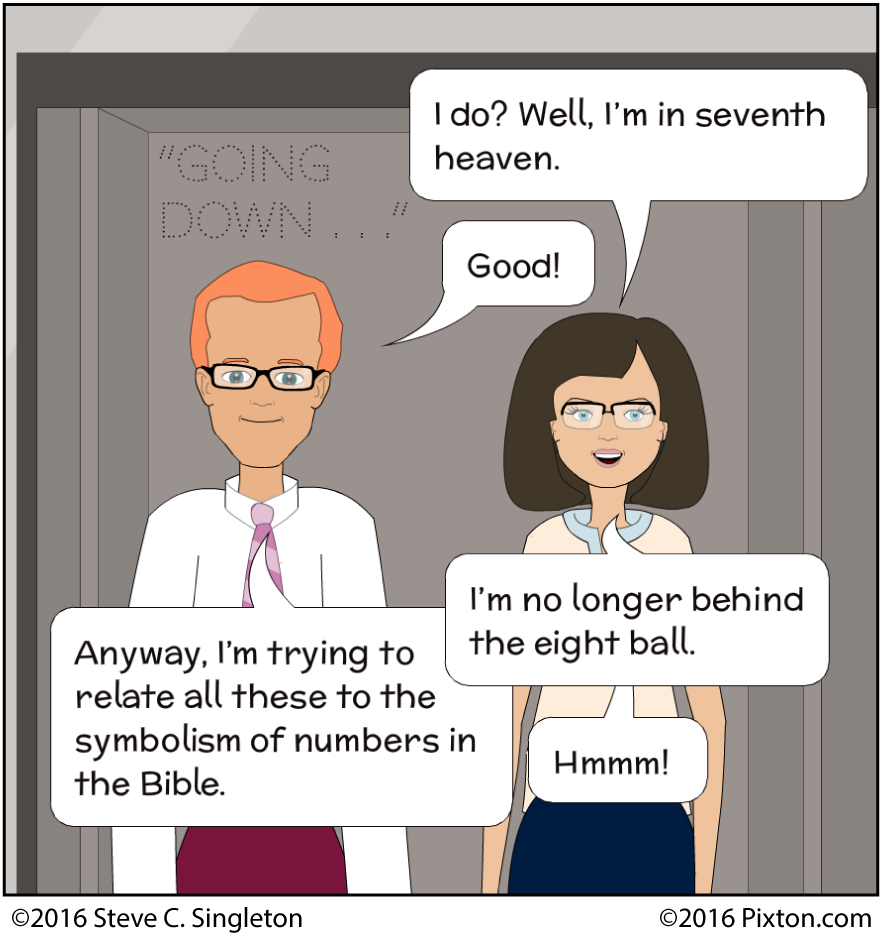The Symbolism of Numbers in Scripture, especially the Apocalypse
Acquiring meaning by association
The symbolic meaning of numbers throughout the Bible has long been a subject of controversy. The fact that those who hold great stock in biblical numerology cannot agree about the meaning of some numbers indicates the high degree of subjectivity involved.
Certainly, from the time of Pythagoras (d. 475 B.C.E.) forward, people have been interested in the meaning of numbers. Certain numbers developed meanings because of associations they habitually had. Some writers, like Davis below, try to minimize the symbolic significance of numbers in Scripture.
Others, such as E. W. Bullinger, try to find figurative meaning in nearly every number that occurs. For instance, the number of fish that the disciples caught at Jesus’ direction, 153 (John 21:11), seems to be significant only as an historical detail validating the account. Bullinger, however, explores the mystical significance of the number.
I have tried to navigate between these two extremes, selecting only instances in which the significance is rather straightforward.
Squares and cubes of numbers, as well as the doubling of digits, seem to have the significance of intensifying the original meaning of the number. See for example, 70 times 7 (or 77 times) in Gen. 4:24, Dan. 9:24, and Matt. 18:22 and 10,000 times 10,000 in Dan. 7:10.
- One – basic to the doctrine of monotheism – Deut. 6:4 and many other passages (God – Rev. 4:3; 11:17; 16:5).
- Two – strength and companionship – Eccl. 4:9-12; Gen. 19:1; Zech. 4:3, 11-12, 14 (two witnesses – Rev. 11:3, 4, 10).
- Three-and-a-half – incompleteness, a broken seven – Dan. 7:25; 9:27; 12:7; see the seven group, below (days – Rev. 11:9, 11; years – 12:14, plus the equivalents – Rev. 11:2, 3; 12:6).
- Four – the world, from the four directions – Isa. 11:12; Jer. 49:36; Ezek. 1:5-10; 37:9; Zech. 2:6; 6:1-8 (Rev. 4:6, 8; 5:6, 8, 14; 6:1, 6; 7:1, 2, 11; 9:14-15; 14:3; 15:7; 19:4; 20:8).
- Five – Because the Law has five books (the Pentateuch: Genesis, Exodus, Leviticus, Numbers, and Deuteronomy), some scholars have connected to the Law the five-fold divisions of the Book of Psalms, as well as what some see as the five sections of the Gospel According to Matthew.
- Six – incompleteness, but in imitation of completeness; only one short of seven – Gen. 1:31; 2:2; Job 5:19; Prov. 6:16 (Rev. 6:12; 9:13-14; 16:12).
- Seven – completeness, based on the seven days of creation and the seven days of the week – Isa. 11:2; Ps. 29; and many, many others (churches – Rev. 1:4, 11, 20; spirits of God – Rev. 1:4; 3:1; 4:5; 5:6; stars – Rev. 1:16, 20; 2:1; 3:1 ). Many scholars find this symbolic meaning carried over into the many lists of seven items and the compositional structure of certain biblical books. (See Labuschagne’s article below.)
- Ten – a round number (ten fingers) used extensively by humans to organize groups of people – Exod. 18:21, 25; Deut. 1:15; Amos 5:3; sometimes used with the same significance of completeness as seven – Gen. 31:7, 41; Num. 14:22; 1 Sam. 1:8; Neh. 4:12; Job 19:3; Eccl. 7:19; Dan. 1:20; Amos 6:9 (days – Rev. 2:10; horns – Rev. 12:3; 13:1; 17:3, 7, 12, 16; crowns – Rev. 13:1; 17:3; kings – Rev. 17:12).
- 12 – the number God uses to organize humans (12 tribes, 12 apostles); also has the significance of completeness, from the 12 months and the full number of the tribes – Gen. 17:20; 25:16; 35:22; 49:28 (stars – Rev. 12:1; gates, angels, and tribes – Rev. 12:12; foundations and apostles – Rev. 12:14; gates and pearls – Rev. 21:21; crops – Rev. 22:2).
- 14 – The sum of the Hebrew letters in the name ‘David’ (14) is the same as the number of generations in each of the three sections of Matthew’s version of the genealogy of Jesus – Matt. 1:17. Matthew may have been using this subtle way to demonstrate that Jesus is the Son of David.
- 24 – According to 1 Chron. 24:1–19, David divided the priests into 24 groups or “courses,” and the 24 “elders” surrounding God’s throne are dressed like priests (4:4, 10). Roman emperors usually had 12 lictors to execute their judgments, but Domitian doubled the number to 24. (See Dio Cassius, Roman History 67.4.3. For this reference I am indebted to Leonard L. Thompson, The Book of Revelation: Apocalypse and Empire, [Oxford: Oxford University, 1990], 98.)
- 40 – Another number associated with completeness, including the number of days it rained during the Great Flood (Gen. 7:4, 12, 17; 8:6), the number of days Moses was with God atop Mount Sinai (Exod. 24:18; Exod. 34:28; Deut. 9:9, 11, 18, 25), the number of days the spies explored Canaan (Num. 13:25, 34), the number of years the Israelites languished in the wilderness (Exod. 16:35; Num. 14:33-34; Num. 32:13; Deut. 2:7; Deut. 8:2,4; Deut. 29:5; Josh. 5:6; Neh. 9:21), the number of days Elijah traveled to arrive at Mount Horeb (1 Kings 19:8), and the number of days Jesus fasted just after His baptism (Matt. 4:2). Based on the wilderness generation, those who try to make predictions based on prophecy use it (I believe erroneously) as the time in years for one generation when they try to calculate the return of Christ, based on His statement: “This generation will certainly not pass away until all of these things have happened” (Mark 13:30 and parallels in Matt. 24:34 and Luke 21:32).
- 70 – Designated by Moses as the number of years that constitutes the normal lifespan of humans – Ps. 90:10. This number has also been used (I believe erroneously) in various attempts to calculate the return of Christ, based on His statement: “This generation will certainly not pass away….”
- 144 – no Old Testament usage, but could be an intensification of the symbolism of 12 (144: thickness of the wall – Rev. 21:17; 144,000: the redeemed protected by God’s seal – Rev. 7:4; 14:1, 3; [144,000,000 square stadia: the area covered by the New Jerusalem, 12,000 stadia to a side – 21:16]).
- 666 – perhaps an intensification of the meaning of six, though many other explanations are also possible (see the notes on its occurrence at Rev. 13:18, pp. 160-172).
- Thousand – common term for infinite – Exod. 20:6; Ps. 50:10; 105:8; or largeness – Ps. 90:4 (1,000 years – Rev. 20:27; 7000 killed – Rev. 11:13).
- 100 million – a myriad of myriads, an exceedingly large number – Ps. 68:17; Dan. 7:10 (Rev. 5:11).
- 200 million – two myriads of myriads, just about the largest conceivable number (Rev. 9:16).
Want to go deeper?
John J. Davis. Biblical Numerology: A Basic Study of the Use of Numbers in the Bible. Grand Rapids, Mich.: Baker, 1968.
Davis divides the hundreds of instances into four categories of uses: conventional, rhetorical, symbolic, and mystical. He concludes that only the number seven is used symbolically. We could debate the definitions of his categories and suggest that he does not go far enough in recognizing numerical symbolism. Yet Davis has performed a real service in seeking to prove that numbers that occur in historical narratives should be taken literally.
E. W. Bullinger. Number in Scripture: Its Supernatural Design and Spiritual Significance Originally published in 1894. Reprint: Grand Rapids, Mich.: Kregel, 1967.
This is one of the most detailed and exhaustive examinations of numbers and combinations of numbers, gematria, and the significance of the number of elements in lists, etc., all tending toward the complex numerology of Jewish mystics, the Kabbalists. Bullinger certainly goes too far in seeking symbolic meaning in the most unlikely places.
Mikeal C. Parsons. “Exegesis ‘By the Numbers’: Numerology and the New Testament.” Perspectives in Religious Studies 35, 1 (Spring 2008): 25-43.
Discusses the numerological possibilities of the numbers 6, 7, 100, 153, and 276.
William Varner. “Christian Use of Jewish Numerology.” The Master’s Seminary Journal 8, 1 (Spring 1997):47-59.
Discusses the elaborate, confusing, and arcane system of Kabbalah, derived from the Zohar, issuing a strong warning against Christians using the system for biblical exegesis.
Steve Singleton. Can We Solve the 666 Puzzle? Using Interpretation Principles to Illuminate One of the Darkest Verses of the Bible. Garland, Tex.: DeeperStudy, 2003.
Introduction to the practice of gematria in biblical times, with charts of the numerical values of the letters of the Hebrew, Greek, and Latin alphabets. Explains why gematria is perhaps the best approach to solving the mystery of the meaning of 666.




